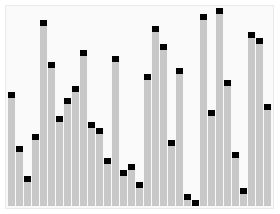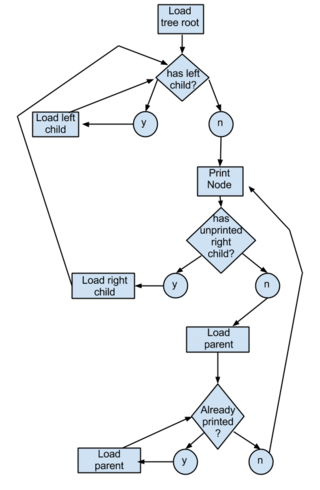Related Research Articles
In computer science, an online algorithm is one that can process its input piece-by-piece in a serial fashion, i.e., in the order that the input is fed to the algorithm, without having the entire input available from the start.
A splay tree is a binary search tree with the additional property that recently accessed elements are quick to access again. Like self-balancing binary search trees, a splay tree performs basic operations such as insertion, look-up and removal in O(log n) amortized time. For random access patterns drawn from a non-uniform random distribution, their amortized time can be faster than logarithmic, proportional to the entropy of the access pattern. For many patterns of non-random operations, also, splay trees can take better than logarithmic time, without requiring advance knowledge of the pattern. According to the unproven dynamic optimality conjecture, their performance on all access patterns is within a constant factor of the best possible performance that could be achieved by any other self-adjusting binary search tree, even one selected to fit that pattern. The splay tree was invented by Daniel Sleator and Robert Tarjan in 1985.

In computer science, a sorting algorithm is an algorithm that puts elements of a list into an order. The most frequently used orders are numerical order and lexicographical order, and either ascending or descending. Efficient sorting is important for optimizing the efficiency of other algorithms that require input data to be in sorted lists. Sorting is also often useful for canonicalizing data and for producing human-readable output.
In computer science, best, worst, and average cases of a given algorithm express what the resource usage is at least, at most and on average, respectively. Usually the resource being considered is running time, i.e. time complexity, but could also be memory or some other resource. Best case is the function which performs the minimum number of steps on input data of n elements. Worst case is the function which performs the maximum number of steps on input data of size n. Average case is the function which performs an average number of steps on input data of n elements.
Daniel Dominic Kaplan Sleator is a Professor of Computer Science at Carnegie Mellon University, Pittsburgh, United States. In 1999, he won the ACM Paris Kanellakis Award for the splay tree data structure.
Introsort or introspective sort is a hybrid sorting algorithm that provides both fast average performance and (asymptotically) optimal worst-case performance. It begins with quicksort, it switches to heapsort when the recursion depth exceeds a level based on (the logarithm of) the number of elements being sorted and it switches to insertion sort when the number of elements is below some threshold. This combines the good parts of the three algorithms, with practical performance comparable to quicksort on typical data sets and worst-case O(n log n) runtime due to the heap sort. Since the three algorithms it uses are comparison sorts, it is also a comparison sort.

In computer science, a self-balancing binary search tree (BST) is any node-based binary search tree that automatically keeps its height small in the face of arbitrary item insertions and deletions. These operations when designed for a self-balancing binary search tree, contain precautionary measures against boundlessly increasing tree height, so that these abstract data structures receive the attribute "self-balancing".
In computer science, a selection algorithm is an algorithm for finding the th smallest value in a collection of ordered values, such as numbers. The value that it finds is called the th order statistic. Selection includes as special cases the problems of finding the minimum, median, and maximum element in the collection. Selection algorithms include quickselect, and the median of medians algorithm. When applied to a collection of values, these algorithms take linear time, as expressed using big O notation. For data that is already structured, faster algorithms may be possible; as an extreme case, selection in an already-sorted array takes time .
In computing, a cache-oblivious algorithm is an algorithm designed to take advantage of a processor cache without having the size of the cache as an explicit parameter. An optimal cache-oblivious algorithm is a cache-oblivious algorithm that uses the cache optimally. Thus, a cache-oblivious algorithm is designed to perform well, without modification, on multiple machines with different cache sizes, or for a memory hierarchy with different levels of cache having different sizes. Cache-oblivious algorithms are contrasted with explicit loop tiling, which explicitly breaks a problem into blocks that are optimally sized for a given cache.

In computer science, quickselect is a selection algorithm to find the kth smallest element in an unordered list, also known as the kth order statistic. Like the related quicksort sorting algorithm, it was developed by Tony Hoare, and thus is also known as Hoare's selection algorithm. Like quicksort, it is efficient in practice and has good average-case performance, but has poor worst-case performance. Quickselect and its variants are the selection algorithms most often used in efficient real-world implementations.

Quicksort is an efficient, general-purpose sorting algorithm. Quicksort was developed by British computer scientist Tony Hoare in 1959 and published in 1961. It is still a commonly used algorithm for sorting. Overall, it is slightly faster than merge sort and heapsort for randomized data, particularly on larger distributions.
sort is a generic function in the C++ Standard Library for doing comparison sorting. The function originated in the Standard Template Library (STL).

A tree sort is a sort algorithm that builds a binary search tree from the elements to be sorted, and then traverses the tree (in-order) so that the elements come out in sorted order. Its typical use is sorting elements online: after each insertion, the set of elements seen so far is available in sorted order.
The k-server problem is a problem of theoretical computer science in the category of online algorithms, one of two abstract problems on metric spaces that are central to the theory of competitive analysis. In this problem, an online algorithm must control the movement of a set of kservers, represented as points in a metric space, and handle requests that are also in the form of points in the space. As each request arrives, the algorithm must determine which server to move to the requested point. The goal of the algorithm is to keep the total distance all servers move small, relative to the total distance the servers could have moved by an optimal adversary who knows in advance the entire sequence of requests.
In computer science, introselect is a selection algorithm that is a hybrid of quickselect and median of medians which has fast average performance and optimal worst-case performance. Introselect is related to the introsort sorting algorithm: these are analogous refinements of the basic quickselect and quicksort algorithms, in that they both start with the quick algorithm, which has good average performance and low overhead, but fall back to an optimal worst-case algorithm if the quick algorithm does not progress rapidly enough. Both algorithms were introduced by David Musser in, with the purpose of providing generic algorithms for the C++ Standard Library that have both fast average performance and optimal worst-case performance, thus allowing the performance requirements to be tightened.
In computer science, the ski rental problem is a name given to a class of problems in which there is a choice between continuing to pay a repeating cost or paying a one-time cost which eliminates or reduces the repeating cost.
The List Update or the List Access problem is a simple model used in the study of competitive analysis of online algorithms. Given a set of items in a list where the cost of accessing an item is proportional to its distance from the head of the list, e.g. a Linked List, and a request sequence of accesses, the problem is to come up with a strategy of reordering the list so that the total cost of accesses is minimized. The reordering can be done at any time but incurs a cost. The standard model includes two reordering actions:
In computer science, partial sorting is a relaxed variant of the sorting problem. Total sorting is the problem of returning a list of items such that its elements all appear in order, while partial sorting is returning a list of the k smallest elements in order. The other elements may also be sorted, as in an in-place partial sort, or may be discarded, which is common in streaming partial sorts. A common practical example of partial sorting is computing the "Top 100" of some list.
In information theory, the computationally bounded adversary problem is a different way of looking at the problem of sending data over a noisy channel. In previous models the best that could be done was ensuring correct decoding for up to d/2 errors, where d was the Hamming distance of the code. The problem with doing it this way is that it does not take into consideration the actual amount of computing power available to the adversary. Rather, it only concerns itself with how many bits of a given code word can change and still have the message decode properly. In the computationally bounded adversary model the channel – the adversary – is restricted to only being able to perform a reasonable amount of computation to decide which bits of the code word need to change. In other words, this model does not need to consider how many errors can possibly be handled, but only how many errors could possibly be introduced given a reasonable amount of computing power on the part of the adversary. Once the channel has been given this restriction it becomes possible to construct codes that are both faster to encode and decode compared to previous methods that can also handle a large number of errors.
References
- Sleator, D.; Tarjan, R. (1985), "Amortized efficiency of list update and paging rules", Communications of the ACM, 28 (2): 202–208, doi: 10.1145/2786.2793 .
- Aspnes, James (1998), "Competitive analysis of distributed algorithms", in Fiat, A.; Woeginger, G. J. (eds.), Online Algorithms: The State of the Art, Lecture Notes in Computer Science, vol. 1442, pp. 118–146, doi:10.1007/BFb0029567, ISBN 978-3-540-64917-5 .
- Borodin, A.; El-Yaniv, R. (1998), Online Computation and Competitive Analysis, Cambridge University Press, ISBN 0-521-56392-5 .
- Awerbuch, B.; Kutten, S.; Peleg, D. (1992), "Competitive Distributed Job Scheduling", ACM STOC, Victoria, BC, Canada.